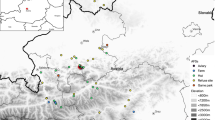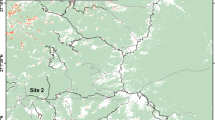Abstract
Brown spiny rats (Maxomys rajah) were translocated from continuous secondary forest to small isolated patches of remnant native forest embedded within Acacia mangium plantation in the Planted Forest Zone of Sarawak, East Malaysia, and fitted with tracking spools to monitor behaviours in novel environments and to record responses to a range of habitat edge features. Forest roads, large clearings and acacia plantation compartments were found to pose barriers to dispersal of brown spiny rats over short temporal scales, whereas old regenerating haul trails were readily crossed on 50% of the encounters. Downed woody debris accounted for a greater proportion of the travel route compared with brown spiny rats tracked in secondary and primary forest in Sabah, which may represent heightened predator avoidance in new environments. Provision of downed woody debris within plantation compartments may improve the dispersal ability of brown spiny rats in this modified landscape, and thus promote metapopulation dynamics and colonisation of vacant habitat patches.
Similar content being viewed by others
References
Bakker VJ (2006) Microhabitat features influence the movements of red squirrels (Tamiasciurus hudsonicus) on unfamiliar ground. J Mamm 87(1):124–130
Boitani L, Catullo G, Marzetti I, Masi M, Rulli M, Savini S (2006) The Southeast Asian mammal databank; a tool for conservation and monitoring mammal diversity in Southeast Asia. Instituto di Ecologia Applicata, Roma
Brinkerhoff RJ, Haddad NM, Orrock JL (2005) Corridors and olfactory predator cues affect small mammal behavior. J Mamm 86(4):662–669
Chan B, Kho PCS, Lee HS (1998) In: Proceedings of planted forests in Sarawak; an international conference. Forest Department Sarawak, Sarawak Timber Association, Sarawak Development Institute
Chapman CA, Naughton-Treves L, lawes MJ, Wasserman MD, Gillespie TR (2007) Population declines of colobus in Western Uganda and conservation value of forest fragments. Int J Primatol 28:513–528
Debinski DM, Holt RD (1999) A survey and overview of habitat fragmentation experiments. Conserv Biol 14(2):342–355
Desrochers A, Hanski IK, Selonen V (2003) Siberian flying squirrel responses to high- and low-contrast forest edges. Landsc Ecol 18:543–552
Diffendorfer JE, Gaines MS, Holt RD (1995) Habitat fragmentation and movement of three small mammals–Sigmodon, Microtus and Peromyscus. Ecology 76(3):827–839
Fahrig L, Merriam G (1994) Conservation of fragmented populations. Conserv Biol 8:50–59
Harrington GN, Freeman AND, Crome FHJ (2001) The effects of fragmentation of an Australian tropical rain forest on populations and assemblages of small mammals. J Trop Ecol 17:225–240
Hin HK, Lading E (2000) Development of Lanjak-Entiman wildlife sanctuary as a totally protected area, phase II; a species inventory of small mammals for the development of Lanjak-Entiman wildlife sanctuary. ITTO Workshop Proceedings
Innes J, Watts C, Fitzgerald N, Thornburrow D, Burns B, Mackay J, Speedy C (2007) Behaviour of invader ship (roof, black) rats behind pest-proof fences. Xclude It; Issue 3. Xcluder Pest Proof Fencing Company, Cambridge, New Zealand
Jacquemyn H, Butaye J, Hermy M (2003) Impacts of restored patch density and distance from natural forests on colonization success. Restor Ecol 11(4):417–423
Maryanto I, Kartono AP, Sinaga MAH (2000) Survey of mammals on different land use types. In: Gillison AN (ed) Above ground biodiversity assessment working group summary report 1996–1999: impact of different land uses on biodiversity and social indicators. ASB Working Group Report, ICRAF, Nairobi
McAdam AG, Kramer DL (1998) Vigilance as a benefit of intermittent locomotion in small mammals. Animal Behav 55:109–117
McConkey KR (2005) Influence of faeces on seed removal from gibbon droppings in a dipterocarp forest in Central Borneo. J Trop Ecol 12:117–120
Miura S, Yasuda M, Ratnam LC (1997) Who steals the fruits? Monitoring frugivory of mammals in a tropical rain forest. Malay Nat J 50:183–193
Murcia C (1995) Edge effects in fragmented forests: implications for conservation. Trends Ecol Evol 10:58–62
Nakagawa M, Miguchi H, Sato K, Nakashizuka T (2007a) A preliminary study of two sympatric Maxomys rats in Sarawak, Malaysia: spacing patterns and population dynamics. Raffles Bull Zool 55(2):381–387
Nakagawa M, Miguchi H, Sato K, Sakai S, Nakashizuka T (2007b) Population dynamics of arboreal and terrestrial small mammals in a tropical rainforest, Sarawak, Malaysia. Raffles Bull Zool 55(2):389–395
Oderdonk DA, Chapman CA (2000) Coping with forest fragmentation: the primates of Kibale National Park, Uganda. Int J Primatol 21(4):587–611
Padoch C, Peluso NL (2003) Borneo people and forests in transition: an introduction. In: Padoch C, Peluso NL (eds) Borneo in transition: people, forests, conservation and development. Oxford University Press, Oxford, UK
Payne J, Francis CM (2005) A field guide to the mammals of Borneo. The Sabah Society, Kota Kinabalu, Malaysia
Salwasser H, Schonewald-Cox C, Baker R (1996) The role of interagency cooperation in managing for viable populations. In: Soule ME (ed) Viable populations for conservation. Cambridge University Press, Cambridge, UK
Silvertown J (1990) Introduction to plant population ecology, 2nd edn. Longman Scientific and Technical, Essex, UK
Spellerberg IF, Sawyer JWD (1999) An introduction to applied biogeography. Cambridge University Press, Cambridge, UK
Stuebing RB (2005) Wildlife conservation in the planted forests of Sarawak: blind ambition? In: Tuen AA, Das I (eds) Wallace in Sarawak–150 years later. An international conference on biogeography and biodiversity. Institute of Biodiversity and Environmental Conservation, Universiti Malaysia, Sarawak, Kota Samarahan
Stuebing RB, Gasis J (1989) A survey of small mammals within a Sabah tree plantation in Malaysia. J Trop Ecol 5:203–214
Waldien DL, Hayes JP, Huso MMP (2006) Use of downed wood by Townsend’s chipmunks (Tamias townsendii) in Western Oregon. J Mamm 87(3):454–460
Wells KL (2005) Impacts of rainforest logging on non-volant small mammal assemblages in Borneo. Thesis, Department of Experimental Ecology, University of Ulm, Ulm, Germany
Wells K, Pfeiffer M, Lakim MB, Linsenmair KE (2004) Use of arboreal and terrestrial space by a small mammal community in a tropical rain forest in Borneo, Malaysia. J Biogeogr 31:641–652
Wheatley M, Fisher JT, Larsen K, Litke J, Boutin S (2005) Using GIS to relate small mammal abundance and landscape structure at multiple spatial extents: the northern flying squirrel in Alberta, Canada. J Appl Ecol 42:577–586
Woon WC, Norini H (2002) Trends in Malaysian forest policy. Policy Trend Report 2002, pp 12–28
Yasuda M, Miura S, Nor Azman H (2000) Evidence for food hoarding behaviour in terrestrial rodents in Pasoh Forest Reserve, a Malaysian lowland rain forest. J Trop For Sci 12(1):164–173
Yasuda M, Ishii N, Okuda T, Nor Azman H (2003) Small mammal community: habitat preference and effects after selective logging. In: Okuda T, Manokaran N, Matsumoto Y, Niiyama K, Thomas SC, Ashton PS (eds) Pasoh: ecology of a lowland rain forest in Southeast Asia. Springer–Verlag, Tokyo, pp 533–546
Zollner PA, Crane KJ (2003) Influence of canopy closure and shrub coverage on travel along coarse woody debris by eastern chipmunks (Tamais striatus). Am Midl Nat 150:151–157
Acknowledgements
Much thanks to Wayne Wooff and the management of Grand Perfect Conservation (GP Con) for allowing us the opportunity to work with them and their team in the Planted Forest Zone, for organizing the field expeditions, and for all the invaluable information and advice offered. We also wish to thank the GP Con team and all of the field staff for their hard work and patience in the field. Thanks also go to the Sarawak Timber Association (STA), and particularly to Barney Chan and Peter Kho for their parts in giving us the opportunity to carry out research work in Sarawak, and especially for their continued support and hospitality. Thank you to our supervisory team: Hamish Cochrane, David Norton and Robert Stuebing. Finally, we also wish to thank the University of Canterbury Scholarships Office, the New Zealand Postgraduate Study Abroad Award and to the McKelvey Fund (School of Forestry) for their generous funding, without which this ongoing research program would not be possible.
Author information
Authors and Affiliations
Corresponding author
Rights and permissions
About this article
Cite this article
Shadbolt, A.B., Ragai, R. Effects of habitat fragmentation on the movement patterns and dispersal ability of the brown spiny rat (Maxomys rajah) in the Planted Forest Zone of Sarawak, Eastern Malaysia. Biodivers Conserv 19, 531–541 (2010). https://doi.org/10.1007/s10531-009-9729-9
Received:
Accepted:
Published:
Issue Date:
DOI: https://doi.org/10.1007/s10531-009-9729-9




